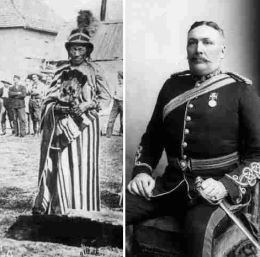150 75 militia Designated 1950 Result Canadian victory | 5–12 dead75-100 wounded at Loon Lake and Frenchman Butte 7 wounded Date 3 June 1885 | |
 | ||
Similar Battle of Cut Knife, Battle of Frenchman's Butte, Battle of Fort Pitt, Battle of Duck Lake, Battle of Fish Creek | ||
The Battle of Loon Lake concluded the North-West Rebellion on June 3, 1885 and was the last battle fought on Canadian soil. It was fought in what was then the District of Saskatchewan of the Northwest Territories, at what is now known as Steele Narrows, in Saskatchewan's Makwa Lake Provincial Park.
Contents
Led by Major Sam Steele, a force of North-West Mounted Police, Alberta Mounted Rifles and Steele's Scouts (a body of mounted militia raised by Steele himself) caught up with and dispersed a band of Plains Cree warriors and their white and Métis hostages.
Cree scouts made a determined stand with what was left of their ammunition, but the body of the Cree column, realizing the hopelessness of their situation, released their prisoners and fled. The Cree casualties were four dead and dozens wounded.
Wandering Spirit, the war chief leading the Cree military campaign, surrendered to authorities at Fort Pitt. Big Bear, the aging peacetime chief of this band of Cree, eluded capture until July 2.
Battle of loon lake
Maps
Legacy
The site of the battle was designated as a National Historic Site of Canada in 1950.
In the spring of 2008, Tourism, Parks, Culture and Sport Minister Christine Tell proclaimed in Duck Lake, that "the 125th commemoration, in 2010, of the 1885 Northwest Resistance is an excellent opportunity to tell the story of the prairie Métis and First Nations peoples' struggle with Government forces and how it has shaped Canada today." The Battle of Loon Lake is commemorated today by interpretive signs placed by the Government of Saskatchewan and a plaque placed by the Historic Sites and Monuments Board of Canada. The place is today known as 'Steele Narrows'. The Narrows between Makwa Lake and Sanderson Bay, in the Makwa Lake Provincial Park, was the site of the last engagement of the rebellion. Steele Narrows Provincial Historic Park conserves the lookout point of a Cree burial ground.
